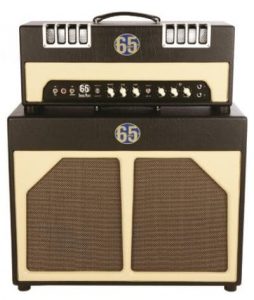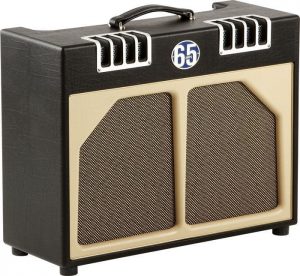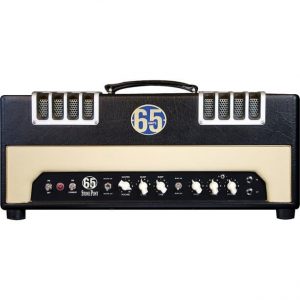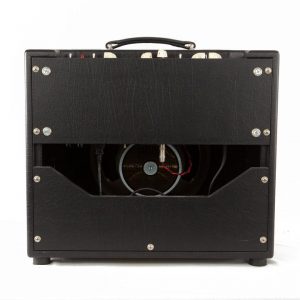Based in California, 65Amps founders Peter Stroud and Dan Boul set out to build the best valve amplifiers on the market. Huw Price finds out what the fuss is all about. Inspired largely by the great British amps of the ’60s – the Marshall 18W, JTM45 and plexi, the Vox AC15, AC30 and AC50 – 65Amps has been making waves among tone-keen guitarists for several years. We’ve got two for review, the 25W 65 Amps Stone Pony and the 12W Lil’ Elvis. But before we dive into the differences between these amps, let’s have a look at what they have in common.

This company is known for achieving great versatility through innovative circuitry and these amps keep that flag flying with a brand new feature. A bypassable Master Voltage circuit has replaced the previous bypassable Master Volume arrangement. And it’s capable of taking the power of the amp down to two or three watts. The basic idea is that the feel and responsiveness of the amp is retained even at low volume. Because the output tubes are always working to their optimum potential. This is apparently a modified version of the power-scaling VVR2 kit sold by Dana Hall. And 65Amps’ version can be retrofitted to any sub-50W model with a master volume.
Both amps have two speaker outputs with an 8/16 Ohm switch, and the cabinets are made from Baltic plywood. The external finishing is superb. And it’s even better inside. This is handwiring at its finest. With a slew of carbon composite resistors and Sozo caps. These amps aren’t cheap, but it’s easy to see why.
Stone Pony
Table of Contents
The Stone Pony’s name refers to the legendary New Jersey venue where the likes of Bruce Springsteen and Bon Jovi paid their dues. Perhaps it’s also a subtle reference to the Rolling Stones. Specifically Keith Richards’ use of Ampeg VT-40 amps back in the late ’60s and early 1970s. Dan Boul and Peter Stroud of 65Amps have always been huge fans of the VT-40 amp and the 7591 power tubes that drove it. Despite the fact that they’ve got a ‘one trick pony’ reputation.

So they decided to match an Ampeg-inspired power stage to their well-regarded and versatile preamp design that features an EF86/12AX7 cathode follower feeding a 12AX7 phase inverter. The tone stack was also tweaked to bring out the best from the 7591 power valves. And special transformers were developed in conjunction with the well-regarded Mercury Magnetics company.
Pros and Cons
7591 tubes look similar to 6V6s but they’re noted for their aggressive clean tone and nice, fat midrange (they were sometimes used in vintage hi-fi amps). The aluminium chassis is drilled for two extra power tubes because the 65 Amps Stone Pony is also available in a high power 50W version. Despite having an 5AR4 tube to handle rectification duties. There’s also a Standby switch – a sensible belt-and-braces feature.
Reading from the input side the controls are Volume, Treble and Bass. There’s a Master control for the Master Voltage, followed by a full-on version of 65Amps‘ Bump feature. Once activated from the footswitch or front panel. The six-way Bump Level switch progressively bypasses the tone stack. As signal passes through a conventional tone stack it becomes attenuated. One reason that amps with complex tone controls usually have extra valves to maintain signal levels. Amps with single tone controls, or no tone control whatsoever, tend to break up early with a fat juicy midrange. Just like many of the tweed Fenders. Bump Tone also deactivates the Bass and Treble controls, so it’s a very welcome additional feature.

Sounds
The 65 Amps Stone Pony was paired up with 65Amps’ 2×12″ open-backed cabinet with an unusual combination of a Celestion G12H Greenback and an Alnico Gold. The Gold is a very efficient speaker and the G12H is no slouch. So it’s no surprise that this 25W amp gets very loud. However. It’s not one of those quick-breakup amps. Overdrive comes on gradually, and it’s always accompanied by a chiming clarity that will make any sound engineer’s day. To my ears the tube choice provides a hint of 6L6 glassiness with a throatier midrange that combines superbly with the British bark of the speakers.
The Bass and Treble controls provide plenty of range. So up to about halfway on the Volume the 65 Amps Stone Pony will do just about any clean tone from funk to mellow jazz. Things get really exciting as you venture beyond halfway. A juicy overdrive creeps in that sounds like a cross between a blackface Fender and a non-master volume Marshall. There’s also plenty of ‘feel’ under your fingers for a great dynamic response.

The ‘feel’ gets even better when you engage Bump, and at Level 1 you can set Bump Tone to match up to the Bump off sound. Albeit with a very slightly beefier and grittier midrange. Moving up the Bump levels is a bit like stepping chronologically though the various Fender tweed circuits of the 1950s. As well as getting raunchier and dirtier, the midrange fattens up considerably. Bump Tone is useful for retaining bite and cutting through the mix.
Volume
Gain levels can get pretty extreme, but the absence of a mid control means you can’t get far into scooped modern metal sounds. However, this amp is in no way confined to retro duties. The definition and bass focus ensure that there’s an almost infinite variety of drive tones are on offer from jangly, chiming crunch to dark distortion. The only drawback is a slight tendency towards microphonics at ultra-high gain. And volume levels – but show me an EF86 amp that doesn
The Stone Pony’s versatility is quite remarkable. But it’s achieved without resorting to multiple gain stages and complex equalisation. Instead, the Bump feature actually ‘removes’ circuitry incrementally. And the fact that you can activate this feature via the HOSA footswitch makes the Stone Pony behave almost like a channel-switching amp.’t.
It gets even better, because there’s also a front panel Boost switch that operates whether Bump is activated or not. The Hi and Lo inputs also offer quite different sensitivity. So you could leave Boost activated and use an A/B switcher to toggle between the inputs for rhythm and solo work. Great, and adaptable too.
Verdict
The 65 Amps Stone Pony gets you close to multi-channel versatility without complexity or processed sound quality. I’m very impressed – this amp’s inherent transparency offers something genuinely different. It’s also very well thought out, and flexible enough for all manner of live and recording applications.

Leave a Reply
You must be logged in to post a comment.